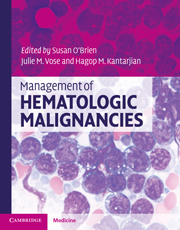Book contents
- Frontmatter
- Contents
- List of contributors
- 1 Molecular pathology of leukemia
- 2 Management of acute myeloid leukemia
- 3 Treatment of acute lymphoblastic leukemia (ALL) in adults
- 4 Chronic myeloid leukemia
- 5 Chronic lymphocytic leukemia/small lymphocytic lymphoma
- 6 Myelodysplastic syndromes (MDS)
- 7 Hairy cell leukemia
- 8 Acute promyelocytic leukemia: pathophysiology and clinical results update
- 9 Myeloproliferative neoplasms
- 10 Monoclonal gammopathy of undetermined significance, smoldering multiple myeloma, and multiple myeloma
- 11 Amyloidosis and other rare plasma cell dyscrasias
- 12 Waldenstrom's macroglobulinemia/lymphoplasmacytic lymphoma
- 13 WHO classification of lymphomas
- 14 Molecular pathology of lymphoma
- 15 International staging and response criteria for lymphomas
- 16 Treatment approach to diffuse large B-cell lymphomas
- 17 Mantle cell lymphoma
- 18 Follicular lymphomas
- 19 Hodgkin lymphoma: epidemiology, diagnosis, and treatment
- 20 Treatment approaches to MALT/marginal zone lymphoma
- 21 Peripheral T-cell lymphomas
- 22 Mycosis fungoides and Sézary syndrome
- 23 Central nervous system lymphoma
- 24 HIV-related lymphomas
- 25 Lymphoblastic lymphoma
- 26 Burkitt lymphoma
- Index
- References
21 - Peripheral T-cell lymphomas
Published online by Cambridge University Press: 10 January 2011
- Frontmatter
- Contents
- List of contributors
- 1 Molecular pathology of leukemia
- 2 Management of acute myeloid leukemia
- 3 Treatment of acute lymphoblastic leukemia (ALL) in adults
- 4 Chronic myeloid leukemia
- 5 Chronic lymphocytic leukemia/small lymphocytic lymphoma
- 6 Myelodysplastic syndromes (MDS)
- 7 Hairy cell leukemia
- 8 Acute promyelocytic leukemia: pathophysiology and clinical results update
- 9 Myeloproliferative neoplasms
- 10 Monoclonal gammopathy of undetermined significance, smoldering multiple myeloma, and multiple myeloma
- 11 Amyloidosis and other rare plasma cell dyscrasias
- 12 Waldenstrom's macroglobulinemia/lymphoplasmacytic lymphoma
- 13 WHO classification of lymphomas
- 14 Molecular pathology of lymphoma
- 15 International staging and response criteria for lymphomas
- 16 Treatment approach to diffuse large B-cell lymphomas
- 17 Mantle cell lymphoma
- 18 Follicular lymphomas
- 19 Hodgkin lymphoma: epidemiology, diagnosis, and treatment
- 20 Treatment approaches to MALT/marginal zone lymphoma
- 21 Peripheral T-cell lymphomas
- 22 Mycosis fungoides and Sézary syndrome
- 23 Central nervous system lymphoma
- 24 HIV-related lymphomas
- 25 Lymphoblastic lymphoma
- 26 Burkitt lymphoma
- Index
- References
Summary
Introduction
The T-cell non-Hodgkin lymphomas are a group of uncommon malignancies that in Western countries account for 15–20% of aggressive lymphomas and between 5% and 10% of all non-Hodgkin's lymphomas (NHL). Within the most current classification schemata, there are 21 distinct diseases that together constitute the mature T- and natural killer (NK)-cell lymphomas, diseases that range from indolent cutaneous lymphomas to aggressive malignancies that are often resistant to routine systemic therapy. Common to many of the types of T-cell lymphoma is a predilection towards extranodal disease, although sites of tropism vary among subtypes. Geographic frequencies of many subtypes, and of T-cell lymphomas as a group, are also highly variable: while only 1.5% of lymphomas are of T-cell lineage in Vancouver, Canada, 18.3% of lymphomas in Hong Kong show a T-cell phenotype. And in Asia, 47.4% of T-cell lymphomas are either NK/T-cell lymphoma, nasal type (NK/T-NT) or adult T-cell leukemia/lymphoma (ATLL), while in North America and Europe, these constitute only 7.1% and 5.3% of T-cell lymphomas, respectively. These variable incidence rates may in part represent differential exposure to risk factors for T-cell lymphoma, including Epstein–Barr virus (EBV) and human T-cell leukemia virus-1 (HTLV-1). As will be explored below, the epidemiologic variety across the subtypes of T-cell lymphoma is matched by the clinical heterogeneity of these diseases, confounding investigation (or understanding) of the class of diseases as a single entity.
- Type
- Chapter
- Information
- Management of Hematologic Malignancies , pp. 410 - 431Publisher: Cambridge University PressPrint publication year: 2010



